|
|
|
|
|
The Republican sponsors of the Hawley Smoot Tariff were Senator Reed Smoot and Representative Willis C. Hawley. The effect of law was to raised U.S. tariffs on over 20,000 imported goods to the highest levels in US history. The Hawley Smoot Tariff seriously backfired as furious European countries imposed a tax on American goods making them too expensive to buy in Europe, and restricting trade which contributed to the economic crisis of the Great Depression. What was the Purpose of the Hawley Smoot Tariff? The purpose of the Hawley Smoot Tariff was to raise tariffs on imports to protect American manufacturers from foreign competition. Why did the Hawley Smoot Tariff do? By raising tariffs to record levels the Hawley Smoot Tariff resulted in Americans buying few foreign products which infuriated countries in Europe. What effect did the Hawley Smoot Tariff have? Countries in Europe angrily responded to the Hawley Smoot Tariff by raising their own tariffs against American goods that had the effect of reducing US sales overseas. Why was the Hawley Smoot Tariff important? The Hawley Smoot Tariff seriously backfired. It was important due to its impact on foreign trade. American products were too expensive to buy in Europe, and restricted trade. The loss of exports intensified the impact of the Great Depression. Facts about
Hawley Smoot Tariff The Hawley Smoot Tariff brought the U.S. tariff to the highest protective level in the history of the United States of America. U.S. exports to Europe saw a massive fall from $2,341 million in 1929 to $784 million in 1932. The policy of Isolationism in the 1920's aimed at self-advancement to make the United States economically self-reliant continued with the passage of the Hawley Smoot Tariff Act. The Hawley Smoot Tariff furthered the US policy of Protectionism and its principle of imposing higher tariffs on foreign goods. The Hawley Smoot Tariff was the last legislation under which the U.S. Congress set actual tariff rates. More than 1,000 economists made the risks of the bill clear to President Herbert Hoover but he ignored them and signed the act into law. Over twenty countries retaliated against the act by raising their own tariffs against American goods. The policies of the US government fostered suspicion, opposition and distrust overseas due to discrimination across trading partners. Farmers had suffered a severe overproduction crisis during the 1920s that had resulted in low prices of agricultural crops. In his presidential campaign Republican Herbert Hoover had pledged to help farmers by raising tariffs on imports of farm products. Hoover believed this action would also protect US industries and employment. In 1934 Democrat President Franklin D. Roosevelt signed the Reciprocal Trade Agreements Act in 1934 that reduced tariff levels and promoted trade liberalization and cooperation with foreign governments moving to free international trade and reducing American Isolationism in the 1930's |
| US American History |
| 1929-1945: Depression & WW2 |
|
|
|
|
|
First Published2016-04-19 | |||
|
Updated 2018-01-01 |
Publisher
Siteseen Limited
| ||
|
|

